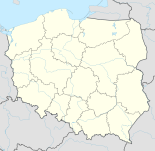Gązwa
| Gązwa | ||
|---|---|---|

|
|
|
| Basic data | ||
| State : | Poland | |
| Voivodeship : | Warmia-Masuria | |
| Powiat : | Mrągowo | |
| Gmina : | Mrągowo | |
| Geographic location : | 53 ° 54 ' N , 21 ° 14' E | |
| Residents : | 126 (2011) | |
| Postal code : | 11-700 | |
| Telephone code : | (+48) 89 | |
| License plate : | NMR | |
| Economy and Transport | ||
| Street : | Kiersztanowo - ( Stamka ) ↔ Stama - Sorkwity / DK 16 | |
| Rail route : | no rail connection | |
| Next international airport : | Danzig | |
Gązwa [ ˈɡɔ̃zva ] ( German Gonswen , 1938–1945 Gansen ) is a village in the Polish Warmian-Masurian Voivodeship . It belongs to the Gmina Mrągowo ( rural community Sensburg ) in the powiat Mrągowski ( Sensburg district ).
Geographical location
Gązwa is located in the Warmian-Masurian Voivodeship , seven kilometers northwest of the district town of Mrągowo ( German Sensburg ).
history
1572 is considered to be the founding year of the small village of Gonswen . At that time, the governor Andreas Jonas prescribed 22 hooves to Johann Gonswa . The village was totally destroyed during the Tatar invasion in 1657 and almost completely depopulated during the Great Plague in 1709/10 .
From 1874 to 1945 Gonswen was in the District Kerstin Owen ( Polish Kiersztanowo ) integrated, the - 1938 in the district of Kersten renamed - to Sensburg in Administrative district Gumbinnen (1905 Government district Allenstein ) in the Prussian province of East Prussia belonged.
Due to the provisions of the Versailles Treaty , the population voted in the referendums in East and West Prussia on July 11, 1920 on whether they would continue to belong to East Prussia (and thus Germany) or join Poland. In Gonswen, 220 residents voted to remain with East Prussia, Poland did not cast any votes.
For political and ideological reasons of defense foreign-appearing place names Gonswen was (officially certified on July 16) on 3 June 1938 in geese renamed .
As a result of the war, the place came to Poland in 1945 with all of southern East Prussia and was given the Polish form of the name Gązwa . Today, the village seat of a Schulz Office ( Polish Sołectwo ) and as such, a town in the composite of Gmina Mrągowo (Town Sensburg ) in mrągowo county (Kreis Sensburg ) until 1998, the Olsztyn Province (Olsztyn) , since the Warmia and Mazury belong.
Population numbers
| year | number |
|---|---|
| 1818 | 99 |
| 1839 | 134 |
| 1867 | 215 |
| 1885 | 355 |
| 1898 | 354 |
| 1905 | 372 |
| 1910 | 387 |
| 1933 | 318 |
| 1939 | 314 |
| 2011 | 126 |
church
Until 1945 Gonswen or Gansen was parish in Warpuhnen ( Polish Warpuny ) in the Protestant or Catholic parish and thus belonged to the church province of East Prussia of the Evangelical Church of the Old Prussian Union or to the diocese of Warmia at that time .
Today there is also Gązwa's relation to Warpuny to the churches there, which, however, now belong to the Masuria diocese of the Evangelical-Augsburg Church in Poland and the current Archdiocese of Warmia in the Polish Catholic Church .
traffic
Gązwa is on a side road that leads from Kiersztanowo (Kerstinowen , 1938–1945 Kersten) via Stama (large trunk) to Sorkwity (Sorquitten) . There is no connection to the rail network .
Individual evidence
- ↑ Polish Postal Code Directory 2013, p. 254
- ↑ Dietrich Lange: Geographical Register of Places East Prussia (2005): Gansen
- ↑ a b c Gonswen at GenWiki
- ↑ Rolf Jehke: District Kerstin Owen / Kersten
- ↑ Herbert Marzian , Csaba Kenez : self-determination for East Germany. Documentation on the 50th anniversary of the East and West Prussian referendum on July 11, 1920. Editor: Göttinger Arbeitskreis , 1970, p. 112
- ^ Uli Schubert: Community directory, district of Sensburg
- ^ Michael Rademacher: German administrative history from the unification of the empire in 1871 to the reunification in 1990. District Sensburg (Polish Mragowo). (Online material for the dissertation, Osnabrück 2006).
- ↑ Wieś Gązwa w liczbach
